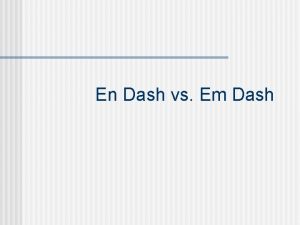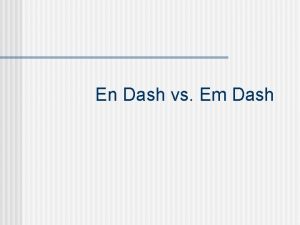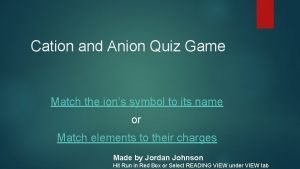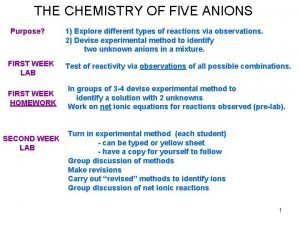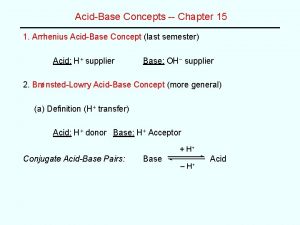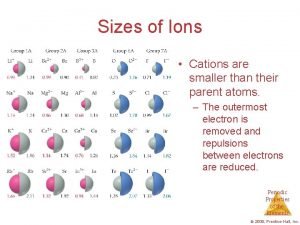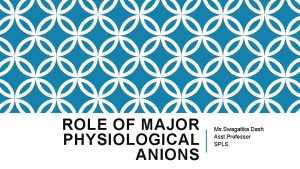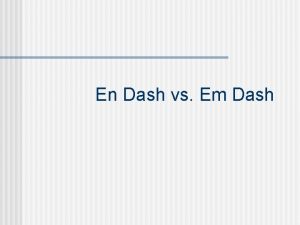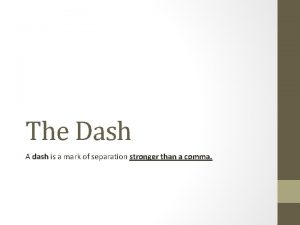Role of major physiological anions Ms Swagatika Dash











- Slides: 11

Role of major physiological anions Ms. Swagatika Dash Asst. Professor SPLS

CHLORIDES • The total chloride ion present in the body is about 50 m. Eq per kg • • body weight and daily requirement is about 5 -10 g as Na. Cl. The dietary source is common table salt used in cooking. Chloride ions get excreted mainly through urine and through skin during sweating. Functions 1. Chloride ion with sodium ion is able to maintain osmotic balance between different body fluids. 2. It is able to maintain the charge balance between the body fluids. 3. Chloride ion take part in formation of gastric HCl and also in maintainance of acid-base balance.

Sulphates • The ion is present in very small quantities in plasma and intestinal fluids. • Good dietary sources are animal and plant proteins, having sulphur containing amino acids like cysteine and methionine. • Sulphur containing compounds are important in detoxication mechanism and SH group containing organic compounds in tissue respiration.

BICARBONATE • It is the second largest anion present in the extracellular fluid compartment. • The bicarbonate along with carbonic acid acts as one of the important buffer in maintainenance of acid-base balance.

Phosphates • Phosphate ion is a major anion of the intracellular fluid compartment. • The main dietary sources are milk, milk products, whole grains legumes, nuts etc. Almost 4/5 th of the total body phosphate is present in teeth and bones along with calcium. • It is also present in the cells as phospholipids, ATP or DNA & RNA. It is known to play vital role in buffering system of the body.

Electrolytes used in replacement therapy • Under the normal physiological conditions body mechanism adjusts the electrolyte balance and no replacement is necessary. • However, under some conditions (prolonged fever, severe vomiting or diarrhoea, there occurs heavy loss of water and electrolytes. • Administration of that electrolyte in appropriate in concentration becomes necessary. • Usually, electrolyte salts of sodium, potassium, calcium are used singly or in combination with other constituents (dextrose, invert sugar, mannitol etc. )

Replacement of sodium Sodium Chloride (Na. Cl) • Molecular weight-58. 54 • It contains not less than 99. 5% and not more than 100. 5% of Na. Cl with no added substances. • Preparations • In laboratory, it can be obtained by passing HCl gas in aqueous solution of common salt. The crystals are precipitated out. • Industrially it is prepared (i) by evaporation of sea water and then purification (ii) by purifying rock salt. • Properties • Physical • It is a white crystalline powder or colourless crystals, odourless and has saline taste. It is freely soluble in water and glycerine and insoluble in alcohol. • Chemical • It can be oxidised chemically and liberates chlorine gas.

• With silver nitrate solution, it gives a white water insoluble precipitate of silver chloride which is soluble in ammonia. ASSAY • The 0. 1 g of the substance is dissolved in 50 ml of water in a glass stoppered flask. To it, 50 ml of 0. 1 N silver nitrate solution, 3 ml of nitric acid, 5 ml of nitrobenzene and 2 ml of ferric ammonium sulphate solution are added. • Now the solution is shaken well and is then titrated with 0. 1 N ammonium thiocyanate solution until the water becomes reddish-yellow. • Now-a-days it is analysed by Volhard’s precipitation method with modification. In this method, the aqueous solution is acidified with nitric acid, excess of standard silver nitrate is added. Silver chloride gets precipitated. • Then nitrobenzene is added and excess of silver nitrate is determined by titrating with standard ammonium thiocyanate using ferric ammonium sulphate as indicator. Nitrobenzene prevents interactions of silver chloride with ferric thiocyanate.

• • Storage. It is stored in tightly closed containers in dry place as it absorbs moisture. Uses. It is a source of both sodium and chloride ions. The dosage forms are solutions, tablets and parenteral solutions. 0. 9% w/v solution is isotonic and is used as wet dressing and washing body cavities and tissues. • In the form of injections and infusions, it is used as electrolyte replenisher. When hypertonic solution is given orally it induces vomiting and used in case of poisoning as a first aid. • It is a constituent of Ringer’s solution, sodium chloride and potassium chloride i. v infusion and ORS. • • Preparations. Sodium chloride eye lotion (B. P) Sodium chloride solution (B. P) Sodium chloride injection Sodium chloride hypertonic injection Sodium chloride tablet Sodium chloride and dextrose injection Mannitol and sodium chloride injection (U. S. P)

Replacement of potassium Potassium Chloride (KCl) • • Mol wt-74. 55 It is having not less than 99. 5% of KCl. Preparation. It is obtained from the natural mineral ‘Carnallite’ (KCl. Mg. Cl 2. 6 H 2 O). The raw salt deposit is ground and treated with hot water when less soluble KCl crystallises out from mother liquor. • In laboratory, it can be prepared by the action of HCl on potassium carbonate or bicarbonate.

• Properties • It is available as colourless prismatic or cubical crystals or as white granular powder. It is odourless and possess a saline taste. It is freely soluble in water and aqueous solutions and neutral to litmus. • Uses • The salt is most widely used for oral replacement of potassium in the form of solution. • • However the aqueous solution causes irritation of gastro intestinal tract. It is used intravenously if person can not take it orally or in case of severe hypopotassaemia. It finds use as adjunct in treatment of ‘Myasthenia gravis’, (severe muscular weakness). It is a constituent of oral rehydration salt, sodium chloride and potassium chloride i. v infusion, sodium and potassium chloride and glucose i. v infusion Preparation. Potassium chloride and glucose intravenous infusion (B. P) Potassium chloride and sodium chloride intravenous infusion (B. P) Potassium chloride, sodium chloride and glucose intravenous infusion (B. P)

